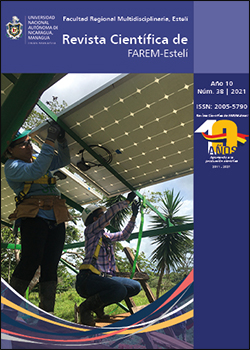Energy efficiency in improved ovens for the production of rosquillas in the city of Condega, Nicaragua, in the year 2020
DOI:
https://doi.org/10.5377/farem.v0i38.11950Keywords:
Energy efficiency, heat transfer, improved kilns, carbon dioxide emissionsAbstract
The baking of rosquillas constitutes an important source of income for families in northern Nicaragua. The purpose of the present study is the energetic analysis of improved and traditional ovens used for the production of rosquillas. The experimental design consisted of analyzing 6 ovens: three traditional and three improved ovens located in Condega municipality of Esteli during the year 2020, performing four repetitions of measurements. The study is based on the philosophical approach of quantitative research, based on the positivist paradigm. The method used is deductive, using techniques such as structured interviews, experimental measurements of temperature and CO2 emissions in the oven infrastructure during the rosquillas firing process, mathematical calculations of heat transfer by convection of the oven barrel, vertical walls, heat dissipated in the chimney, heat transfer by radiation, and heat generated by combustion. Pearson’s correlation statistical technique was applied to check the existence or not of correlations between the various variables. The hypothesis that the improved kilns have higher energy efficiency than traditional kilns was confirmed with 66.8% and 21.4%, respectively. In relation to traditional ovens, the improved ovens have lower CO2 emissions, consume less firewood and are less harmful to health because they produce less smoke.
Downloads
References
Confidencial. (20 de 9 de 2013). Esperan reducir del 45,8% al 10% el consumo de leña para cocinar. Confidencial. Obtenido de Google. Chrome: https://archivo.confidencial.com.ni/
Diario El Mundo, E. S. (19 de Septiembre de 2013). SICA. Obtenido de Google.Chrome: https://www.sica.int/consulta/Noticia.aspx?Idn=81049&idm=1
Hernández Sampieri, R., Fernández Collado, C.; Baptista Lucio, M. d. (2014). Metodologia de la Investigación (Sexta edición ed.). Mexico DF: Mc Graw Hill.
Howell, J., & Buckius, R. (1990). Principios de Termodinámica para Ingenieros. Mexico: Mc Graw Hill.
Inzunza, J. (2002). Introducción a la Mecánica. Obtenido de Introducción a la Mecánica.: https://www2.dgeo.udec.cl/juaninzunza/docencia/docencia.html
Piura López, J. (2006). Metodología de la Investigación Científica: un enfoque integrador. Managua.
Poveda, M. (s.f.). Eficiencia energética: recurso no aprovechado. Propuesta para avanzar de las palabras ala acción. Obtenido de oladeorg: http://biblioteca.olade.org/opac-tmpl/Documentos/old0054.pdf
Published
How to Cite
Issue
Section
License
Copyright (c) 2021 Revista Científica de FAREM-Esteli

This work is licensed under a Creative Commons Attribution-NonCommercial-ShareAlike 4.0 International License.

